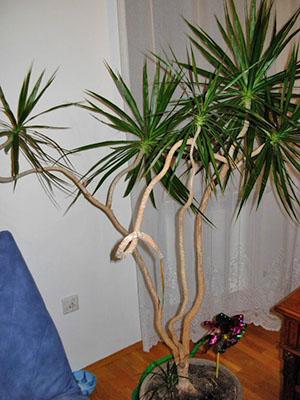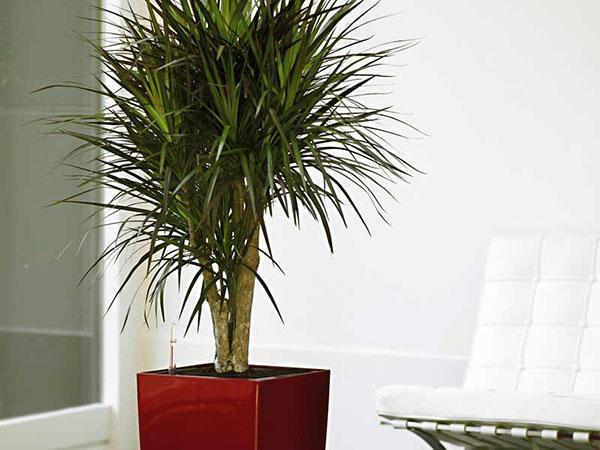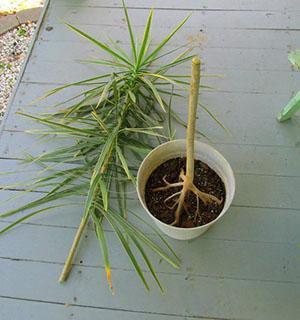Reproduction of dracaena at home is not particularly difficult
 Dracaena with a slender trunk and a lush cap of long, hard foliage is very similar to another southern plant - a palm tree. In the wild, both one and the second culture are tall. But if nothing restricts the palm tree to grow upward, then for an indoor flower this becomes a serious problem.
Dracaena with a slender trunk and a lush cap of long, hard foliage is very similar to another southern plant - a palm tree. In the wild, both one and the second culture are tall. But if nothing restricts the palm tree to grow upward, then for an indoor flower this becomes a serious problem.
Not only that, most domesticated varieties are capable of reaching heights of up to 2-3 meters. Plants lose their decorative effect without restrictive measures. Dracaena trunks become bare, elongate, and a small amount of leaves remains only on the tops of reluctantly branching lignified shoots.
How to propagate dracaena at home?
Faced with such a situation, novice flower growers sometimes seek to get rid of an overgrown pet. But why buy a new plant when there is already a specimen that can easily return to its former beauty? In addition, it is an excellent source of planting material for breeding dracaena at home!
But how does dracaena multiply? In indoor conditions, it practically does not bloom, it is also extremely difficult to achieve the appearance of lateral shoots, and new plants from the roots appear only in exceptional cases.

- apical cuttings;
- stem cuttings;
- air layering;
- seeds.
The first two methods of breeding dracaena at home are the most preferred. They are lightweight and give almost guaranteed results.
When is it better to propagate dracaena at home, and how to properly prepare planting material? You can test in practice the ease of reproduction of dracaena in spring. At this time, not only growth processes are activated, but also the defenses of plants. Therefore, even the most laborious method will definitely give a quick result. But attempts to root cuttings in winter or autumn most often end in failure.
Propagation of dracaena by apical cuttings
 If there is an adult dracaena in the house that has lost its former attractiveness, it's time to update it and grow a young specimen with its help.
If there is an adult dracaena in the house that has lost its former attractiveness, it's time to update it and grow a young specimen with its help.
The top of the shoot covered with leaves together with a part of the stem is cut off with a sharp knife. It is optimal if a clean cut perpendicular to the trunk is 15–18 cm from the last leaf. All leaves and old foliage are removed from the stem. After that, the future dracaena seedling is dried in room conditions for 2-3 hours.
You can root a stalk taken for reproduction of dracaena at home:
- in ordinary water with a small addition of a root stimulant and charcoal;
- in a mixture of crushed coal, sand and peat;
- in vermiculite or perlite at the choice of the grower;
- in steamed soil for dracaena or decorative palm species.
Cuttings should be rooted in a greenhouse or under a film cover, the humidity inside which can be controlled by ventilation. To do this, the shelter is opened twice a day for 15–20 minutes.
It must be remembered that dracaena, propagated at home by cuttings, does not like excessive soil moisture.
To prevent root rudiments from decaying or drying out, you need regular, but very careful watering and maintaining the temperature within the range of 20-22 ° C. Seedlings are good for spraying. Only water is better to take warm and always settled. In the same way, with the help of a spray bottle, plants can receive the first feeding in their life.
A video on how to propagate dracaena at home will help to study the process in detail and get answers to your questions.
 The stem with the root system remaining after cutting should not be thrown away! If you cover the top cut with a bag, and put the plant in a pot in a warm place and water it moderately, then after about a month, the awakened side shoots will become noticeable on the stem. They will give future life to the renewed, already multi-barreled dracaena.
The stem with the root system remaining after cutting should not be thrown away! If you cover the top cut with a bag, and put the plant in a pot in a warm place and water it moderately, then after about a month, the awakened side shoots will become noticeable on the stem. They will give future life to the renewed, already multi-barreled dracaena.
Propagation of dracaena by cuttings from the stem
 If the stem is too long even after pruning and it is a pity to throw it away, you can start propagating dracaena at home with cuttings obtained not from the top, but from the middle of the shoot. The same technique will be useful if, with healthy roots, the top of the plant is withered or rotten.
If the stem is too long even after pruning and it is a pity to throw it away, you can start propagating dracaena at home with cuttings obtained not from the top, but from the middle of the shoot. The same technique will be useful if, with healthy roots, the top of the plant is withered or rotten.
To obtain cuttings, a healthy stem is cut into 10–15 cm pieces so that the cut passes exactly at the place where the leaf was spotted. The cut points must be level and clean, without cracks or peeling of tissue.
Rooting is carried out similarly to the first method of reproduction of dracaena by cuttings. But in this case, it is possible to place pieces of shoots in the substrate not only vertically, deepening a couple of centimeters, but also horizontally, slightly pressing into the wet soil mixture.
If during the rooting of the apical cuttings only roots are formed, then when growing dracaena from the stem cuttings, in addition to the roots, shoots also sprout from the buds that were at rest. Usually, the root system develops in 1–1.5 months, and the first shoots on the cuttings are shown after 2–4 weeks.
Propagation of dracaena by air layers
 When the plant is small, and it is still impossible to get cuttings in order to propagate dracaena at home, use another method:
When the plant is small, and it is still impossible to get cuttings in order to propagate dracaena at home, use another method:
- On the trunk of the plant, under the former leaf, they mark the place of formation of future roots and make a small transverse incision approximately to the middle of the trunk.
- So that it does not overgrow, a match or a toothpick is inserted into the gap.
- Around the incision, the trunk is wrapped in sphagnum and covered with a bag
- It is important that the moss under the film does not dry out; it is moistened with a spray bottle.
- When the roots grow through the sphagnum, the plank is removed and an independent seedling is cut from the mother plant.
Often, in place below the cut, over the past time, the rudiments of shoots are formed, which become new trunks of dracaena.
The separated sprout is rooted in the soil for adult plants, and it is useful to place it in a greenhouse for a week or cover it with a large jar for accelerated acclimatization.
 This method is more complicated than reproduction of dracaena by cuttings taken from the stem or from the top of the shoot, but with proper care, the young seedling takes root and grows much faster.
This method is more complicated than reproduction of dracaena by cuttings taken from the stem or from the top of the shoot, but with proper care, the young seedling takes root and grows much faster.
Propagation of dracaena seeds
At home, it is extremely difficult to cause flowering, and even more so to get seeds. If such a rare planting material is at the disposal of the florist, do not hesitate.
 Dracaena seeds are embedded in the ground only fresh, but before that they are thoroughly cleaned of fruit residues and immersed in a growth stimulant solution for 10-15 minutes:
Dracaena seeds are embedded in the ground only fresh, but before that they are thoroughly cleaned of fruit residues and immersed in a growth stimulant solution for 10-15 minutes:
- Dried seeds are sown on the surface of a wet sandy-peat, disinfected mixture.
- Sprinkle a little with soil, cover with a film or put it in a greenhouse for germination. Seeds require light and a constant temperature of 25 ° C to hatch.
- Until the seeds have sprouted, the greenhouse is regularly ventilated, trying not to let cold air and condensation fall under the film.
- Unsustained shoots should be expected in 25–30 days.
Small dracaena (photo) gradually allow you to get used to the room air. And then the plants are dived and transferred to separate pots.
This is the most difficult and unusual way to reproduce dracaena at home, but it can also bear fruit and replenish the knowledge of the grower about an interesting indoor culture.